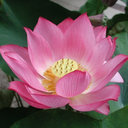Triterpenoidal saponins: bioactive secondary metabolites from Zygophyllum coccineum.
Keywords
Abstract
Phytochemical investigation of the aerial parts of Zygophyllum coccineum L. led to the isolation of nine ursane-type triterpene saponins (1- 9), including the new one; zygophylloside S (1), together with a known flavonoid glycoside (10) and a sterol glycoside (11). The isolated compounds were tested for antifungal activity against several important plant pathogens and for insecticidal activity against two important mosquito species. Among the isolated compounds 1, 3, 5, 6, and 9 showed 32-77 % fungal growth inhibition at a concentration of 30 µM against Phomopsis viticola. Compound 9 showed 90 % and 80 % mosquitocidal activity at 3.1 µg/0.5 µL against Aedes aegypti and Culex quinquefasciatus, respectively.





